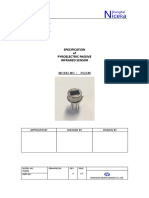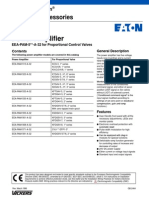0 ratings0% found this document useful (0 votes)
11 viewsECE 2314 Induction Machines CAT III 2024
ECE 2314 Induction Machines CAT III 2024
Uploaded by
ValentineCopyright:
© All Rights Reserved
Available Formats
Download as PDF, TXT or read online from Scribd
ECE 2314 Induction Machines CAT III 2024
ECE 2314 Induction Machines CAT III 2024
Uploaded by
Valentine0 ratings0% found this document useful (0 votes)
11 views1 pageCopyright
© © All Rights Reserved
Available Formats
PDF, TXT or read online from Scribd
Share this document
Did you find this document useful?
Is this content inappropriate?
Copyright:
© All Rights Reserved
Available Formats
Download as PDF, TXT or read online from Scribd
Download as pdf or txt
0 ratings0% found this document useful (0 votes)
11 views1 pageECE 2314 Induction Machines CAT III 2024
ECE 2314 Induction Machines CAT III 2024
Uploaded by
ValentineCopyright:
© All Rights Reserved
Available Formats
Download as PDF, TXT or read online from Scribd
Download as pdf or txt
You are on page 1of 1
MULTIMEDIA UNIVERSITY OF KENYA
ECE 2314 Induction Machines CAT III 22-APR-2024
Instructions: Answer ALL Questions CORRECTLY. (50 Marks) Time: 60 Minutes.
1) 1. What do you understand by the following terms as regards Tx:
a) Derating. (1 Marks)
b) Inrush current. (1 Marks)
2) Explain the factors that decide on the KVA rating of a Tx. (2 Marks)
3) With the aid of neat and well labelled phasor diagrams, show that a Yd1 vector group can translate to a Yd11.
(4 Marks)
4) A 3Φ Δ − Y Tx bank consisting of three 1Φ Tx is used to stepdown the voltage of a 33Φ, 6600 V transmission
line. If the primary line current is 10 A, and turns ratio is 12,calculate:
a) Secondary line voltage. (2 Marks)
b) Line current. (2 Marks)
c) Output KVA. (3 Marks)
5) State any THREE advantages of using a wound rotor over a squirrel cage rotor in an induction machine.
(3 Marks)
6) Consider a loop of wire representing the rotor winding of an induction machine. Show that the induced torque is
a cross product. (3 Marks)
7) With the aid of a neat and well labelled diagram, show & explain the correspondence & difference between a
transformer equivalent circuit and the induction machine equivalent circuit. (4 Marks)
8) With the aid of neat and well labelled diagrams, explain how the Scott-T 3Φ-2Φ conversion is made possible.
(4 Marks)
9) A 600 kVA, 1Φ Tx with 0.012 pu resistance and 0.06 pu reactance is connected in parallel with a 300 kVA Tx
with 0.014 pu resistance and 0.045 pu reactance to share a load of 800 kVA at 0.8 pf lagging. Calculate how
they share the load when:
a) Both the secondary voltages are 440 V. (8 Marks)
b) The open-circuit secondary voltages are respectively 445 V and 455 V. (12 Marks)
10) A 208 V, 10 hp, 4 pole, 60 Hz, Y-connected induction motor has a full-load slip of 5%. At the rated load of this
motor, calculate:
a) Synchronous speed. (1 Marks)
b) Rotor speed. (1 Marks)
c) Rotor frequency. (1 Marks)
d) Shaft torque. (2 Marks)
11) A ∆-Y distribution transformer connects to a power system referenced at V∠00 volts. With the aid of a neat and
well labelled diagram, draw the vector group wiring and vector diagrams of the resulting sub-station
transformer to successfully parallel the two transformers to the power system. (4 Marks)
12) A 6 pole, 50 Hz wound-rotor induction motor when supplied at the rated voltage and frequency with slip-rings
open-circuited, developed a voltage of 100 V between any two rings. Under the same conditions its rotor is now
driven by external means at 1000 rpm opposite to the direction of rotation of stator field. Calculate:
a) Voltage available between slip-rings. (2 Marks)
b) Corresponding frequency. (2 Marks)
13) With the aid of a neat and well labelled diagram, show how losses in an induction motor could be represented
by the power flow diagram. (3 Marks)
14) A 460 V, 25 hp, 60 Hz, 4 pole, Y-connected induction motor has the following impedances in ohms per phase
referred to the stator circuit: 𝑅1 = 641 Ω, 𝑋1 = 1.106Ω, 𝑅2= 332 Ω, 𝑋2= 464 Ω, 𝑋𝑀 = 26.3 Ω. The total
rotational losses are 1100 W and are assumed to be constant. The core loss is Jumped in with the rotational
losses. For a rotor slip of 2.2% at the rated voltage and rated frequency, find the motor’s:
a) Speed. (2 Marks)
b) Stator current. (2 Marks)
c) Power factor. (2 Marks)
You might also like
- The Subtle Art of Not Giving a F*ck: A Counterintuitive Approach to Living a Good LifeFrom EverandThe Subtle Art of Not Giving a F*ck: A Counterintuitive Approach to Living a Good LifeRating: 4 out of 5 stars4/5 (5951)
- Never Split the Difference: Negotiating As If Your Life Depended On ItFrom EverandNever Split the Difference: Negotiating As If Your Life Depended On ItRating: 4.5 out of 5 stars4.5/5 (888)
- Hidden Figures: The American Dream and the Untold Story of the Black Women Mathematicians Who Helped Win the Space RaceFrom EverandHidden Figures: The American Dream and the Untold Story of the Black Women Mathematicians Who Helped Win the Space RaceRating: 4 out of 5 stars4/5 (927)
- Grit: The Power of Passion and PerseveranceFrom EverandGrit: The Power of Passion and PerseveranceRating: 4 out of 5 stars4/5 (619)
- Shoe Dog: A Memoir by the Creator of NikeFrom EverandShoe Dog: A Memoir by the Creator of NikeRating: 4.5 out of 5 stars4.5/5 (545)
- Elon Musk: Tesla, SpaceX, and the Quest for a Fantastic FutureFrom EverandElon Musk: Tesla, SpaceX, and the Quest for a Fantastic FutureRating: 4.5 out of 5 stars4.5/5 (476)
- Her Body and Other Parties: StoriesFrom EverandHer Body and Other Parties: StoriesRating: 4 out of 5 stars4/5 (831)
- The Emperor of All Maladies: A Biography of CancerFrom EverandThe Emperor of All Maladies: A Biography of CancerRating: 4.5 out of 5 stars4.5/5 (274)
- The Yellow House: A Memoir (2019 National Book Award Winner)From EverandThe Yellow House: A Memoir (2019 National Book Award Winner)Rating: 4 out of 5 stars4/5 (99)
- Devil in the Grove: Thurgood Marshall, the Groveland Boys, and the Dawn of a New AmericaFrom EverandDevil in the Grove: Thurgood Marshall, the Groveland Boys, and the Dawn of a New AmericaRating: 4.5 out of 5 stars4.5/5 (270)
- A Heartbreaking Work Of Staggering Genius: A Memoir Based on a True StoryFrom EverandA Heartbreaking Work Of Staggering Genius: A Memoir Based on a True StoryRating: 3.5 out of 5 stars3.5/5 (232)
- Standard Quality Assurance Plan For Ac MotorDocument6 pagesStandard Quality Assurance Plan For Ac MotorSonti Mani kumar100% (2)
- On Fire: The (Burning) Case for a Green New DealFrom EverandOn Fire: The (Burning) Case for a Green New DealRating: 4 out of 5 stars4/5 (75)
- The Unwinding: An Inner History of the New AmericaFrom EverandThe Unwinding: An Inner History of the New AmericaRating: 4 out of 5 stars4/5 (45)
- Manual de Operacion y Partes VCM 200Document40 pagesManual de Operacion y Partes VCM 200CARLOS451100% (1)
- The Little Book of Hygge: Danish Secrets to Happy LivingFrom EverandThe Little Book of Hygge: Danish Secrets to Happy LivingRating: 3.5 out of 5 stars3.5/5 (419)
- Team of Rivals: The Political Genius of Abraham LincolnFrom EverandTeam of Rivals: The Political Genius of Abraham LincolnRating: 4.5 out of 5 stars4.5/5 (235)
- The World Is Flat 3.0: A Brief History of the Twenty-first CenturyFrom EverandThe World Is Flat 3.0: A Brief History of the Twenty-first CenturyRating: 3.5 out of 5 stars3.5/5 (2272)
- The Gifts of Imperfection: Let Go of Who You Think You're Supposed to Be and Embrace Who You AreFrom EverandThe Gifts of Imperfection: Let Go of Who You Think You're Supposed to Be and Embrace Who You AreRating: 4 out of 5 stars4/5 (1110)
- The Hard Thing About Hard Things: Building a Business When There Are No Easy AnswersFrom EverandThe Hard Thing About Hard Things: Building a Business When There Are No Easy AnswersRating: 4.5 out of 5 stars4.5/5 (355)
- The Sympathizer: A Novel (Pulitzer Prize for Fiction)From EverandThe Sympathizer: A Novel (Pulitzer Prize for Fiction)Rating: 4.5 out of 5 stars4.5/5 (124)
- SAMSON Elektropneumatski Pozicioner Tip 4763Document8 pagesSAMSON Elektropneumatski Pozicioner Tip 4763Bojan DimitrijevicNo ratings yet
- Baja Design Report PDFDocument9 pagesBaja Design Report PDFZubair HussainNo ratings yet
- Introduction To TI MSP430Document9 pagesIntroduction To TI MSP430hickimse1No ratings yet
- Model 3000: Trace Oxygen AnalyzerDocument75 pagesModel 3000: Trace Oxygen AnalyzerRaaj SenthieelNo ratings yet
- SC200 Controller DatasheetDocument4 pagesSC200 Controller DatasheetJuan Jose Mamani RoqueNo ratings yet
- Specifications: 2015 G 1.2 MPI KAPPA Automatic Transaxle System SpecificationsDocument49 pagesSpecifications: 2015 G 1.2 MPI KAPPA Automatic Transaxle System SpecificationsHikmah Jevie YusriNo ratings yet
- Viking STPDocument20 pagesViking STPLee Nagle0% (1)
- York SMC Floor Standing Type PDFDocument161 pagesYork SMC Floor Standing Type PDFHaythem FerjaniNo ratings yet
- Mechanical Projects ListDocument3 pagesMechanical Projects ListJatin PahujaNo ratings yet
- ELECS 1 Experiment #3Document20 pagesELECS 1 Experiment #3Aldrin ManeseNo ratings yet
- Brakes Description and OperationDocument17 pagesBrakes Description and Operationlilianadiaz.201074No ratings yet
- Eng DS Esb001n0044l003000 ADocument1 pageEng DS Esb001n0044l003000 AHakan BayrakNo ratings yet
- User Manual Singer 9020 (English - 44 Pages)Document2 pagesUser Manual Singer 9020 (English - 44 Pages)mariamNo ratings yet
- Introduction To: System-on-ChipDocument34 pagesIntroduction To: System-on-ChipNguyen Van ToanNo ratings yet
- P926MDocument7 pagesP926Mhl liNo ratings yet
- Vacon OPTE3 E5 Profibus Option Board User Manual DPD00997C UKDocument117 pagesVacon OPTE3 E5 Profibus Option Board User Manual DPD00997C UKJelenna JennaNo ratings yet
- N350 Electrical Diagram Final - EN JMCDocument124 pagesN350 Electrical Diagram Final - EN JMCLucía jandigNo ratings yet
- Latitude E6400 XFRDocument81 pagesLatitude E6400 XFRSAABNo ratings yet
- PVG 32 Parts CatalogDocument52 pagesPVG 32 Parts CatalogVipin Gupta75% (4)
- Xbox-Ip: Installation GuideDocument16 pagesXbox-Ip: Installation GuidePuRe Sp3ctreNo ratings yet
- Toshiba - Manual For Service Version 2.2Document72 pagesToshiba - Manual For Service Version 2.2VolvoxdjNo ratings yet
- High Voltage DTS 60D DatasheetDocument2 pagesHigh Voltage DTS 60D Datasheetbetho_96No ratings yet
- 12V DC Electric Car JackDocument4 pages12V DC Electric Car Jack2349 Rohit Ramesh GorivaleNo ratings yet
- Harga Ducting (USA)Document14 pagesHarga Ducting (USA)titieNo ratings yet
- XRT1500 ManualDocument60 pagesXRT1500 Manualold.smogNo ratings yet
- Types of InsulatorsDocument10 pagesTypes of InsulatorsFidel Fernandez100% (1)
- 26 05 10 Electrical Testing QA QCDocument3 pages26 05 10 Electrical Testing QA QCTuong Nguyen Duc MinhNo ratings yet
- Eea-Pam 32Document8 pagesEea-Pam 32Johnny Diaz VargasNo ratings yet






































































